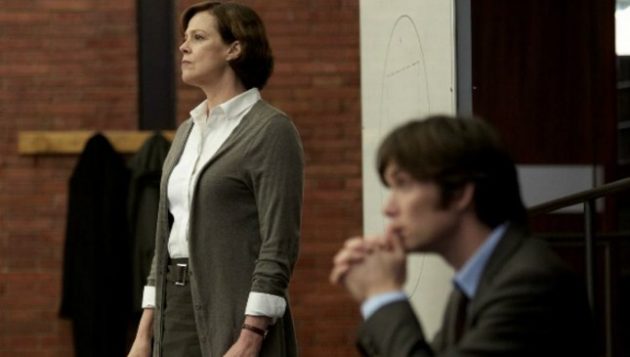REVIEW: A Preposterously Talented Cast Enlivens Muddled Red Lights

Red Lights, the new film from Buried director Rodrigo Cortés, weds an earnest, simplified exploration of the nature of faith with a goofy, gussied-up B-movie plot about a pair of academics who travel around debunking extrasensory phenomenon. As marriages go, it's a troubled one, but it certainly makes for some interesting fights across the dinner table.
Red Lights has formidable resources at its disposal, including an almost preposterously talented cast made up of Sigourney Weaver, Cillian Murphy, Robert De Niro (showing rare flickers of life), Elizabeth Olsen and others, as well as Cortés's own undeniable filmmaking talent. This is a man who managed to draw suspense out of an hour and a half of Ryan Reynolds trapped in a box without even letting the guy take off his shirt. Set free to wander through a genre-inflected landscape filled with would-be clairvoyants summoning spirits in creaky buildings and alleged mystics calling people out of audiences to heal them, he manages to sustain an unsettling tension that lasts until you realize it's a misdirect. As the film moves from a wry but jolt-filled journey with a pair of professional skeptics to a clash between one of them and the world's foremost self-proclaimed psychic, it loses momentum and the sense of the unexpected that gave it fuel. Its most operatic moments are actually its weakest.
That battle escalates between academic Tom Buckley (Murphy) and Simon Silver (De Niro), a famous phenom who's returned to the public eye after years of retirement. Tom is a physicist who, for personal reasons, has ended up as the protégé and sort-of surrogate child of Dr. Margaret Matheson (Weaver), a psychologist and paranormal investigator. Such is the lightly warped reality the film inhabits that the two work in an underfunded branch of a university department called the Scientific Paranormal Research Center, an endeavor more interested in supporting the research led by Paul Shackleton (Toby Jones) to prove the existence of telepathic abilities.
The underlying theme of Red Lights is that the frauds and hustlers Margaret and Tom encounter succeed in duping people because we want to believe them, to see in them evidence that there is something beyond the world as we perceive it. The film generally steers clear of religion (though it contains a nod to phony faith healer Peter Popoff), allowing, for better and worse, table-levitating mediums and spoon-bending telekinetics to augur the potential mysteries of the universe. It's a decision that frees the movie from heavier metaphysical obligations, but it also sets the story wackily off-balance by having as its primary symbols of faith musty ESP stunts like the reading of Zener cards or thoughtography. When Margaret reveals to Tom that the reason she's kept her long-comatose son alive despite the near-impossibility of his waking is that she doesn't believe there's anything beyond death, it feels flimsy that the way she channels this is by proving to the gullible that their houses aren't really haunted.
Weaver and Murphy are good together, their characters' interactions belying fondness, familiarity and trust under the professional reserve. They share a sincere drive to disprove claims of psychic phenomena, though because of what they do they're perceived as wet blankets — "I just hope he shows those smart-ass college know-it-alls," one Silver follower spits when the telepath agrees to let Shackleton and his coworkers test his abilities in a lab. Before Silver swallows the second half of the movie, Margaret and Tom travel around to different sites of reported paranormal activity, scenes Cortés winkingly stages as convincing brushes with the beyond — a seance, a child who can channel spirits, a man with the power to cure illness — before allowing our protagonists to reveal the prosaic reality of what's underneath.
Cortés's restless, circling camera (the cinematographer is Xavi Giménez) gives the film a sense of tension even when little actually comes of it — a jump scare in a scene of Margaret at home seems to exist mainly to show that even a skeptic can be vulnerable to the willies. And Silver, who's blind and escorted everywhere by a smirking assistant played by Joely Richardson, understands that weakness and targets it. Whether or not Silver has actual power is an open question throughout the latter part of the film — he left the public eye after one of his foremost detractors died ominously of a sudden heart attack at one of his shows — but what's certain is that he's a master manipulator.
The "red lights" of the title are the signs Margaret searches for that indicate trickery — hidden motivations, advanced groundwork, glimpses of susceptibility. Silver doesn't seem to show any red lights, though as Tom becomes the film's focus and obsesses with unveiling the man as a fraud, he seems himself less a reliable agent and more one with his own biases to prove. De Niro, preening and smug in his sunglasses, makes for an enigmatically despicable antagonist, but Tom's unbalanced need to take him down feels dictated not by motivation but by the movie itself. Dead birds turn up outside his house, electronics short out in sprays of sparks — coincidence or evidence of Silver's paranormal aggression? The movie muddles to a rug-pulling ending that doesn't, despite its efforts, shed new light on what's come before. Instead, it feels like an unsuccessful attempt to yank the two diverging aspects of the film — its thoughts on faith versus its psychic explorations — together for some finality when they've actually drifted even further apart.
Follow Alison Willmore on Twitter.
Follow Movieline on Twitter.
